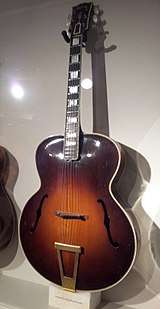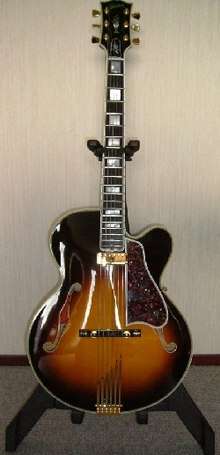Gibson L-5
The Gibson L-5 guitar was first produced in 1922 by the Gibson Guitar Corporation, then of Kalamazoo, Michigan, under the direction of acoustical engineer and designer Lloyd Loar, and has been in production ever since. It was considered the premier guitar of the company during the big band era. It was originally offered as an acoustic instrument, with electric models not made available until the 1940s.
%2C_Maybelle_Carter%2C_CMHF_clip1.jpg)

lower bout width: 17"
%2C_Merle_Travis_-_clip2.jpg)
lower bout width: 18"
Design and construction
Worldwide, the L-5 was the first guitar to feature f-holes. Then as well as today, the construction of the L-5 is similar in construction, carving, bracing and tap-tuning, to building a cello. This guitar as well as the cello are similarly designed in order to amplify and project the acoustic vibration of strings throughout carved and tuned woods, using f-holes as the projection points. From 1922 to 1934 the L-5 was produced with a 16" lower bout width. In 1934 the lower bout was increased to 17"; this width is still used today. Also released in 1934 was the larger 18" archtop guitar named the "L5 Super", which was later renamed the Gibson Super 400. These two highly ornate acoustic guitars are Gibson's top-of-the-line carved archtop instruments. Since the 1930s there have been several other 17" archtops designed by Gibson, including variations introduced to be more affordable, less ornate models.[2]
Today the standard model of the L-5 is the L-5 CES, an electric version designed to minimize the feedback that well-carved archtops are prone to when amplified. CES stands for Cutaway Electric Spanish.
Gibson periodically issues variations of the L-5 built in limited editions of varying size. One example is the thin-bodied "L-5 CT" (cutaway thin), which has the same overall specifications, with the exception of the body thickness. The CT model was first constructed for George Gobel, who wanted a less bulky guitar.
Another variation of the L-5 is the Wes Montgomery model, named for the popular 1950s and 1960s jazz guitarist. The Wes Montgomery model has a single "Classic 57" pickup in the neck position, and an X-brace supporting the top, in the tradition of earlier braces used in the construction of the all-acoustic L-5s. The standard and more popular bracing is the slightly brighter sounding "parallel bracing", which is considered to project the sound farther than an X-braced archtop.
The 1955 Gibson Byrdland model is yet another L-5 variation, designed by Billy Byrd and Hank Garland. The Byrdland guitar has a thin L-5-style body and originally came with a narrower neck that featured a relatively short 23 1/2-inch scale length to aid in playing difficult chords.
Several different L-5 hollow-body models have appeared over the years, including the L-5 Signature and the L-5 Studio. The ES-5 was the first three pickup factory guitar model built. The ES-5 was inspired by the L-5, introduced in 1949, later modified as the Gibson ES-5 Switchmaster. Unlike the L-5 which had a solid carved spruce top and solid maple sides and back, the ES-5 body was constructed of pressed laminated wood to prevent feedback, Gibson also felt that the best tonewoods were not necessary in an electric model and pressed laminated wood would produce a more affordable to manufacture model and thus could land in much more players hands than the carved instruments.
The L-5 CES was a direct electric version of the L-5, introduced in 1951. These originally used P-90 pickups, but used humbucker pickups from 1958 on.[3] From 1961 through 1969, most production L-5CES guitars featured a "florentine" (sharp) cutaway, replacing the "venetian" (rounded) cutaway design.
Notable performers
The L-5 has for multiple generations been seen in the hands of many performers. Much of the RCA fifties recordings of Elvis Presley feature the sound of Scotty Moore's L-5. Nashville session guitarist Hank Garland, who also recorded acclaimed jazz albums before his near-fatal automobile accident, frequently played an L-5. A little known fact - the L-5 is the guitar that Groucho Marx kept by his side throughout his private life. Though not widely known, Marx played the guitar well. Contemporary guitarists who play and have played an L-5 on notable recordings as well as live include Tuck Andress from Tuck and Patti, Melvin Sparks, Lee Ritenour, George Van Eps, and Howard Roberts. John Mayer uses one on his 2008 live CD/DVD Where the Light Is. Eric Clapton used an L-5 to record Reptile (2001) and also used one on his 2002 live CD/DVD One More Car, One More Rider during the songs "Reptile", and "Somewhere Over the Rainbow".
Early players of the L-5 include Eddie Lang, and Maybelle Carter from The Carter Family, who played her now-famous 1928 model for the majority of her career. Maybelle Carter's L-5 is now kept in the Country Music Hall of Fame in Nashville, Tennessee. Django Reinhardt played an L-5 fitted with a DeArmond pickup during his tour with Duke Ellington November 1946.[4] Groucho Marx is seen playing his L-5 in the 1932 Marx Brothers film Horse Feathers.[5] Clint Eastwood featured an L-5 in the 1982 movie Honkytonk Man. This had a cutaway (introduced in 1939), unlikely in a story set during the Great Depression.
Comedian and singer George Gobel had a special version of the Gibson L-5 archtop guitar custom designed and gifted to him by his friend Milton Berle in 1958, the "L-5CT" (cutaway, thin), featuring diminished dimensions of neck scale (24 3/4") and body depth (2 3/8"), befitting his own small stature, and a cherry red finish (for optimal appearance on Gobel's new color TV show). About 45 L-5CT's were produced from 1958 to 1963, making them one of the rarest Gibson models. Most of these were acoustic guitars, although a few were shipped with pickups. The rarest L5 model was a close relative of the L-5CT. It was called the "Crest"*. It was conceived by Gibson employee Andy Nelson (who helped to design the L-5CT) in 1961. It featured the same thinline body of the L-5CT, but the new-for-1961 "florentine" cutaway shape, Super 400-style fretboard inlays, and a unique knight/shield crest design on the headstock. Only six Crests were produced (all in 1961), and no two were identical. Gibson produced another model called a "Crest" in 1969-70, but this was a different type of instrument, similar to an ES-330, but with a rosewood body and floating pickups.
In the 1970s, Gibson produced the L-5S, which was effectively a solid-body version of the L-5 archtop. It was used by Paul Simon and, from 1973–76, by Mark Farner of Grand Funk Railroad (he is seen with the guitar in cover photographs on the band's 1975 live album Caught in the Act); and a custom-made single-pickup version was made for Ronnie Wood, who loaned it to Keith Richards for his 1988 tour with the X-Pensive Winos.[6][7] A double cutaway version of the L-5 has recently been introduced to the market. The body depth has been reduced to 2 3/8". The upper cutaway is purely cosmetic, since the neck base or heel prevents higher access to the frets.
Gallery
References
- Alcantara, Paul. "85558- Gibson L-5". prewargibsonl-5.com. Retrieved 20 May 2018.
Joe Spann...Spann's Guide to Gibson...I conclude that Maybelle's guitar was shipped in January of 1930.
- Gruhn's Guide To Vintage Guitars, 2nd Edition, pg. 140
- http://legacy.gibson.com/Products/Electric-Guitars/Archtop/Gibson-Custom/L-5-CES/Features.aspx
- Django by Michael Dregni, Oxford University Press 2004. Tony Romano, who played with jazz violinist, Joe Venuti, also played the L-5. In fact, he played Eddie Lang's L-5, which was the first produced.
- Jerry McCulley, The Surprisingly Serious Tale of Comedian Groucho Marx and His Lifelong Quest to Master Guitar.
- Carter, Walter. "Adventures in Archives: Trail of Stones Leads to Gibson S-1". Gibson Musical Instruments. Archived from the original on 2008-05-12. Retrieved 2008-02-15.
- Keith Richards & the X-Pensive Winos (1988). Live at the Hollywood Palladium (DVD released 2007)
|format=requires|url=(help). Virgin Records.
| Wikimedia Commons has media related to Gibson L-5. |



_2.jpg)
.jpg)